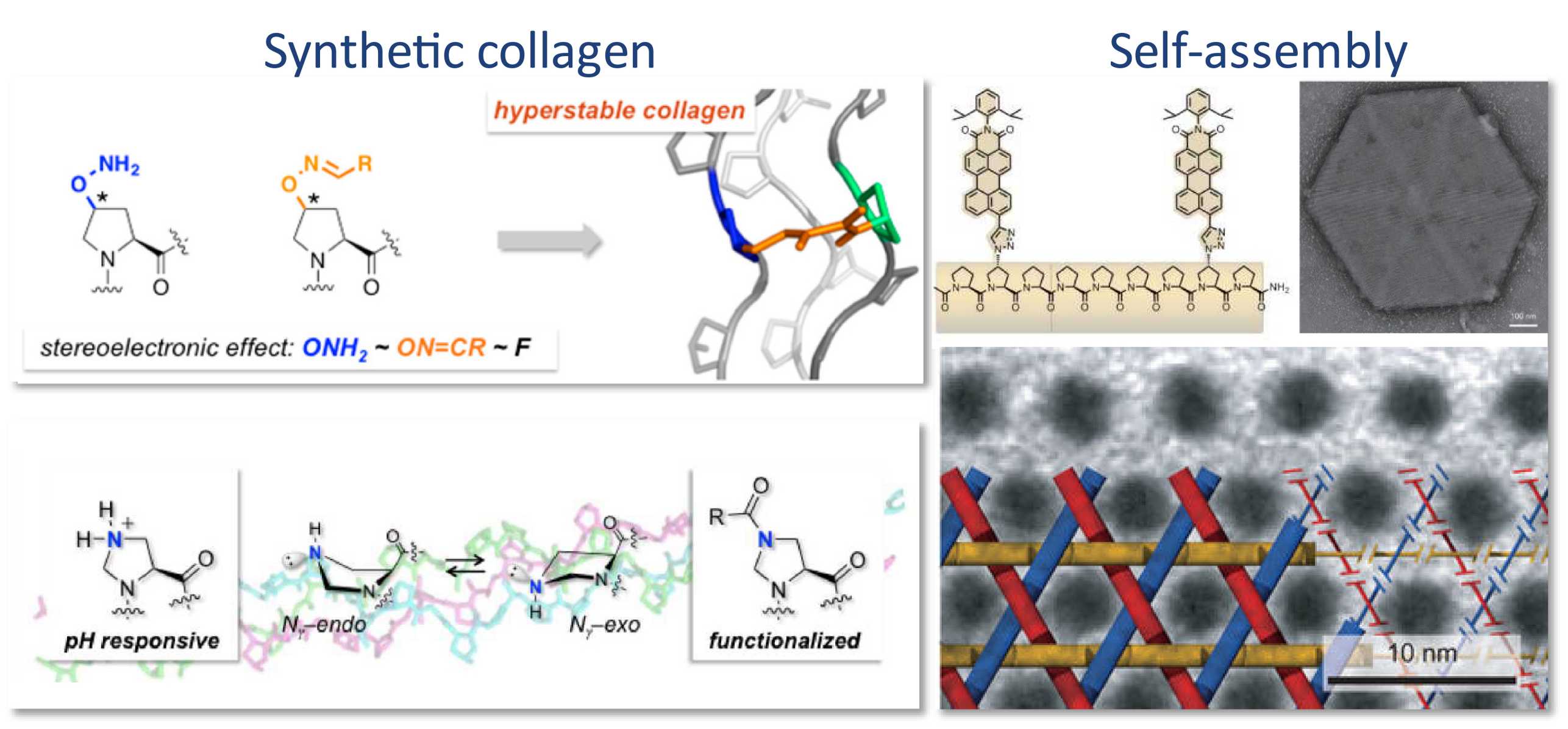Synthetic Materials

Synthetic Collagen
Collagen is the most abundant protein in mammals and the most prevalent constituent of the extracellular matrix. It provides for stability in disparate tissues and organs and plays crucial roles in the modulation of cellular activities.
We utilize functionalizable collagen model peptides (CMPs) to understand the factors that govern the conformational stability of collagen and to develop collagen-based functional materials for medicinal applications such as wound healing or drug delivery. Conformational and kinetic studies of differently functionalized CMPs provided insight into the importance of hydrogen bonding, steric and stereoelectronic effects for the supramolecular integrity of collagen. The studies also illuminated at which positions collagen can be functionalized without disturbing the stability and led to the development of pH-responsive collagen. Further studies are focused on developing new means of increasing stability of triple helices in collagen model peptides. To this end we utilized oxime ligation as a highly efficient cross-linking methodology to achieve triple-helical assemblies of high thermal stability. We also introduced a new synthetic amino-acid γ-aza-proline as a handle allowing for functionalization and achieving pH-responsive behavior of collagen triple helices.
Currently we are building on this knowledge to control the self-assembly of synthetic CMPs into supramolecular structures that resemble the morphology of natural collagen and establish synthetic collagen for medicinal applications.
Selected Publications
M. R. Aronoff, J. Egli, M. Menichelli, H. Wennemers "γ-Azaproline Confers pH-Responsiveness and Functionalizability on Collagen Triple Helices”
Angew. Chem. Int. Ed. 2019, 58, 3143–3146
N. B. Hentzen, L. E. J. Smeenk, J. Witek, S. Riniker, H. Wennemers "Cross-Linked Collagen Triple Helices by Oxime Ligation”
J. Am. Chem. Soc. 2017, 139, 12815–12820
J. Egli, C. Siebler, B. Maryasin, R.S. Erdmann, C. Bergande, C. Ochsenfeld, H. Wennemers, „pH-Responsive aminoproline-containing collagen triple helices”
Chem. Eur. J. 2017, 33, 7938–7944
C. Siebler, R. S. Erdmann, H. Wennemers, "Switchable Proline Derivatives: Tuning the Conformational Stability of the Collagen Triple Helix by pH Changes"
Angew. Chem. Int. Ed. 2014, 53, 10340–1034
R. S. Erdmann, H. Wennemers, "Effect of Sterically Demanding Substituents on the Conformational Stability of the Collagen Triple Helix"
J. Am. Chem. Soc. 2012, 134, 17117–17124
Supramolecular self-assembly
Precise control over the incorporation and ordering of functional building blocks into larger, organized systems is important for the development of new materials.
Our group uses oligoprolines as molecular scaffolds to create and control the morphology of nanostructured materials. We developed conjugates between oligoproline and π-conjugated systems that form hierarchical self-assemblies with morphologies that can be tuned by seemingly subtle modifications on the molecular level. Furthermore we were able to utilise this approach to prepare the first example of an extended triaxial supramolecular weave held together solely through the interplay of weak non-covalent interactions. The micrometre-scale material proved to be more robust than non-woven self-assemblies consisiting of the same building block. Additionally the uniform hexagonal pores of the interwoven network were able to host iridium nanoparticles.
Building on the detailed understanding of the supramolecular organization of oligoproline–chromophore conjugates, we are currently designing novel molecular architectures for applications in molecular electronics. We are also expanding our work on extended woven topologies to create novel supramolecular materials for gas storage and catalysis.
Selected Publications
U. Lewandowska, W. Zajaczkowski,* S. Corra,* J. Tanabe, R. Borrmann, E. M. Benetti, S. Stappert, K. Watanabe, N. A. K. Ochs, R. Schaeublin, C. Li, E. Yashima, W. Pisula, K. Müllen, H. Wennemers "A Triaxial Supramolecular Weave"
Nat. Chem. 2017, 9, 1068–1072
U. Lewandowska, W. Zajaczkowski, W. Pisula, Y. Ma, C. Li, K. Müllen, H. Wennemers "Effect of Structural Modifications on the Self-Assembly of Oligoprolines Conjugated with Sterically Demanding Chromophores"
Chem. Eur. J. 2016, 22, 3804–3809
U. Lewandowska, W. Zajaczkowski, L. Chen, F. Bouillière, D. Wang, K. Koynov, W. Pisula, K. Müllen, H. Wennemers, "Hierarchical Supramolecular Assembly of Sterically Demanding π-Systems by Conjugation with Oligoprolines"
Angew. Chem. Int. Ed. 2014, 53, 12537–12541
